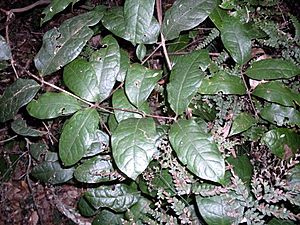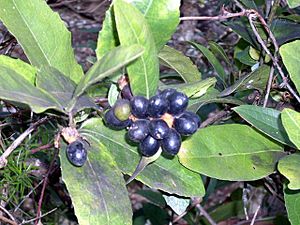Common wilkiea facts for kids
Quick facts for kids Common wilkiea |
|
|---|---|
 |
|
| Wilkiea huegeliana at Macquarie Pass National Park, Australia | |
| Scientific classification | |
| Genus: |
Wilkiea
|
| Species: |
huegeliana
|
| Synonyms | |
|
* Mollinedia huegeliana Tul. |
|
The Wilkiea huegeliana is a common small tree. It grows in the rainforests of eastern Australia. People also call it the common wilkiea, tetra beech, or veiny wilkiea. A French scientist named Louis René Tulasne first described this plant. Later, Alphonse Pyramus de Candolle gave it its current scientific name.
You can find this tree from Mount Dromedary near Narooma in southern New South Wales. Its range extends north to Maryborough in southern Queensland. It especially likes to grow in volcanic soils. These are rich soils formed from old volcanoes.
The common wilkiea lives in the understorey of rainforests. This means it grows beneath the taller trees. It can be found in almost all types of rainforests. However, it does not grow in very cold temperate forests.
About the Common Wilkiea

The Wilkiea huegeliana can be a shrub or a small tree. It can grow up to 8 meters (about 26 feet) tall. Its trunk can be up to 10 centimeters (about 4 inches) wide. The trunk is often bent or uneven. It does not have large root supports called buttresses.
The bark of the tree is usually smooth. It can be brown or grayish. On older, larger trees, the bark might look a bit scaly.
Leaves of the Tree
The leaves of the common wilkiea are 5 to 13 centimeters (2 to 5 inches) long. They are also 1 to 5 centimeters (0.4 to 2 inches) wide. The leaves grow in pairs, opposite each other on the stem. They are oval or oblong in shape. Most leaves have jagged edges, like tiny teeth. Sometimes, they have smooth edges.
The top of the leaf is rounded. The part near the stem tapers to a point. The top side of the leaf is dark and shiny. The underside is duller and lighter in color. The leaf stalks are 3 to 11 millimeters long. You can see the veins on the leaves very clearly, especially on the underside.
Flowers and Fruit
The Wilkiea huegeliana has separate male and female plants. This means a single plant will have either male flowers or female flowers, but not both. The flowers are yellow-green and smell nice. They bloom from September to February.
The fruit ripens from May to September. The part that holds the fruit is shiny black. It is 7 to 12 millimeters (about 0.3 to 0.5 inches) across. It does not have a stalk. Several of these fruits grow together on a cup-shaped base. Birds eat the fruit and drop the seeds. The fresh seeds are white and stand out on the dark forest floor. This helps them grow into new plants.
A tiny insect called Thrips setipennis likely helps pollinate the Wilkiea huegeliana. These small insects have been found inside both the male and female flowers. They help carry pollen from one flower to another.
See also
 In Spanish: Wilkiea huegeliana para niños
In Spanish: Wilkiea huegeliana para niños

